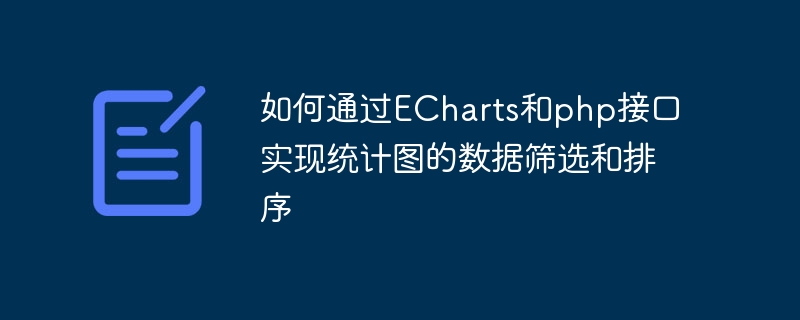Home >Backend Development >PHP Tutorial >How to implement data filtering and sorting of statistical charts through ECharts and php interfaces
How to implement data filtering and sorting of statistical charts through ECharts and php interfaces
- WBOYWBOYWBOYWBOYWBOYWBOYWBOYWBOYWBOYWBOYWBOYWBOYWBOriginal
- 2023-12-17 22:55:031001browse

How to implement data filtering and sorting of statistical charts through ECharts and PHP interfaces
In the field of modern data analysis and visualization, ECharts is a powerful JavaScript chart library. It has been widely used in various data visualization projects. At the same time, PHP, as a popular server-side programming language, can be combined with ECharts to provide convenient solutions for filtering and sorting data. This article will introduce how to use ECharts and PHP interfaces to implement data filtering and sorting of statistical charts, and provide specific code examples.
1. Set up a PHP environment and configure ECharts
First, we need to set up a PHP development environment and configure ECharts. For specific installation steps, please refer to the official documentation of PHP and ECharts.
2. Create HTML page and JavaScript code
Create an HTML file in the root directory, name it index.html, and introduce ECharts related resource files in the
tag:<!DOCTYPE html>
<html lang="en">
<head>
<meta charset="UTF-8">
<title>ECharts数据筛选和排序示例</title>
<script src="echarts.min.js"></script>
</head>
<body>
<div id="chart" style="width: 600px;height:400px;"></div>
<script src="script.js"></script>
</body>
</html>Create a JavaScript file named script.js in the same directory, and write ECharts-related code in it:
// 使用ECharts的示例数据进行演示
var data = [
{name: '北京', value: 100},
{name: '上海', value: 200},
{name: '广州', value: 300},
{name: '深圳', value: 400},
{name: '成都', value: 500}
];
// 创建ECharts实例
var chart = echarts.init(document.getElementById('chart'));
// 设置图表的配置项和数据
var option = {
title: {
text: '统计图'
},
tooltip: {},
xAxis: {
data: data.map(function(item) {
return item.name;
})
},
yAxis: {},
series: [{
name: '数量',
type: 'bar',
data: data.map(function(item) {
return item.value;
})
}]
};
// 使用配置项和数据生成图表
chart.setOption(option);3. Create a PHP interface
Create a PHP file named api.php on the server side, and write code for processing data filtering and sorting in it:
<?php
// 根据请求参数筛选和排序数据
$action = $_GET['action'];
if ($action == 'filter') {
// 根据条件筛选数据
$filter = $_GET['filter'];
// 进行数据筛选的逻辑处理
// ...
// 返回筛选后的数据
echo json_encode($filteredData);
} else if ($action == 'sort') {
// 根据条件排序数据
$sort = $_GET['sort'];
// 进行数据排序的逻辑处理
// ...
// 返回排序后的数据
echo json_encode($sortedData);
}
?>4. Call the PHP interface in JavaScript code
Add the following code in the script.js file to send data requests to the PHP interface and update the chart:
// 发送筛选请求
function filterData(filter) {
var xhr = new XMLHttpRequest();
xhr.onreadystatechange = function() {
if (xhr.readyState == 4 && xhr.status == 200) {
var filteredData = JSON.parse(xhr.responseText);
// 更新图表数据
option.xAxis.data = filteredData.map(function(item) {
return item.name;
});
option.series[0].data = filteredData.map(function(item) {
return item.value;
});
chart.setOption(option);
}
};
xhr.open('GET', 'api.php?action=filter&filter=' + filter, true);
xhr.send();
}
// 发送排序请求
function sortData(sort) {
var xhr = new XMLHttpRequest();
xhr.onreadystatechange = function() {
if (xhr.readyState == 4 && xhr.status == 200) {
var sortedData = JSON.parse(xhr.responseText);
// 更新图表数据
option.xAxis.data = sortedData.map(function(item) {
return item.name;
});
option.series[0].data = sortedData.map(function(item) {
return item.value;
});
chart.setOption(option);
}
}
xhr.open('GET', 'api.php?action=sort&sort=' + sort, true);
xhr.send();
}
// 示例:点击按钮筛选数据
document.getElementById('filterBtn').onclick = function() {
var filter = document.getElementById('filterInput').value;
filterData(filter);
};
// 示例:点击按钮排序数据
document.getElementById('sortBtn').onclick = function() {
var sort = document.getElementById('sortInput').value;
sortData(sort);
};5. Run and test
Open the index.html file in the browser, And enter filtering or sorting conditions as needed and click the corresponding button. Through data interaction with the PHP interface, ECharts charts will automatically update based on the returned results, and implement data filtering and sorting functions.
Summary
Through the above steps, we successfully implemented data filtering and sorting of statistical charts through ECharts and PHP interfaces. By writing specific PHP interfaces and calling these interfaces in JavaScript code to interact with the server for data, we can achieve flexible control of chart data, making filtering and sorting of data more convenient and flexible. I hope this article will help you understand and apply the relevant knowledge of ECharts and PHP interfaces.
The above is the detailed content of How to implement data filtering and sorting of statistical charts through ECharts and php interfaces. For more information, please follow other related articles on the PHP Chinese website!

